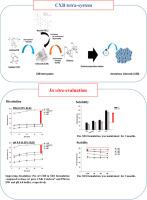塞来昔布- ufl2®-双聚合物-壳聚糖固体分散体系的开发及其溶解度和渗透性评价
IF 6.5
Q1 CHEMISTRY, APPLIED
Carbohydrate Polymer Technologies and Applications
Pub Date : 2025-08-07
DOI:10.1016/j.carpta.2025.100972
引用次数: 0
摘要
药物增溶是目前的主要挑战。因此,固体分散(SD)法用于药物的溶解和固化已有60多年的历史。本研究采用SD法(溶剂蒸发法)研究四元体系对塞来昔布(CXB)的增溶稳定性。该策略是通过使用UFL2®提高pH值和分散性来改善CXB的溶解度。此外,双聚合物促进了增溶,壳聚糖实现了稳定。通过理化性质、溶出度、渗透性、溶解度、稳定性等试验,确定了最佳的SD1配方。最佳配方(CXB:UFL2®:IR®:K12®:壳聚糖= 200:150:100:100:50,质量比)在不同溶出介质中的溶出度(%)分别比西乐brex®高1.81倍、2.56倍和1.73倍。在四种膜的渗透性评价中,其结果优于Celebrex®。特别地,SD1配方中的CXB从结晶形态转变为非晶形态,并伴有热变化和氢相互作用。此外,SD1配方在3个月内保持稳定。综上所述,SD1配方具有较强的溶解性、溶解度和渗透性,具有工业应用价值。改良配方的动物试验也有望产生令人鼓舞的结果。本文章由计算机程序翻译,如有差异,请以英文原文为准。

Development of celecoxib-UFL2®-dual polymer-chitosan solid dispersion using a tetra-system and evaluation of its solubility and permeability
Drug solubilization is currently a major challenge. Therefore, the solid dispersion (SD) method has been used for over 60 years to solubilize and solidify drugs. This study aimed to investigate the solubilization and stabilization of celecoxib (CXB) using a tetra system with the SD method (solvent evaporation). The strategy was to improve CXB solubility by increasing the pH and dispersibility using UFL2®. Additionally, solubilization was promoted using a dual polymer, and stabilization was achieved using chitosan. The optimal SD1 formulation was confirmed based on physicochemical properties, dissolution, permeability, solubility, and stability tests. The dissolution (%) of the optimal SD1 formulation (CXB:UFL2®:IR®:K12®:chitosan = 200:150:100:100:50, weight ratio) was significantly improved, 1.81-, 2.56-, and 1.73-fold higher than that of Celebrex® in different dissolution media with sodium lauryl sulfate (SLS, 0.25 % w/v). In permeability evaluations of four types of membranes, it showed results superior to those of Celebrex®. In particular, CXB in the SD1 formulation changed from a crystalline to an amorphous form, with the accompanying thermal changes and hydrogen interactions. Moreover, the SD1 formulation remained stable for three months. In conclusion, the SD1 formulation has strong dissolution, solubility, and permeability and is considered worthy of industrial use. Animal testing with the improved formulations is also expected to yield encouraging results.
求助全文
通过发布文献求助,成功后即可免费获取论文全文。
去求助

 求助内容:
求助内容: 应助结果提醒方式:
应助结果提醒方式:


